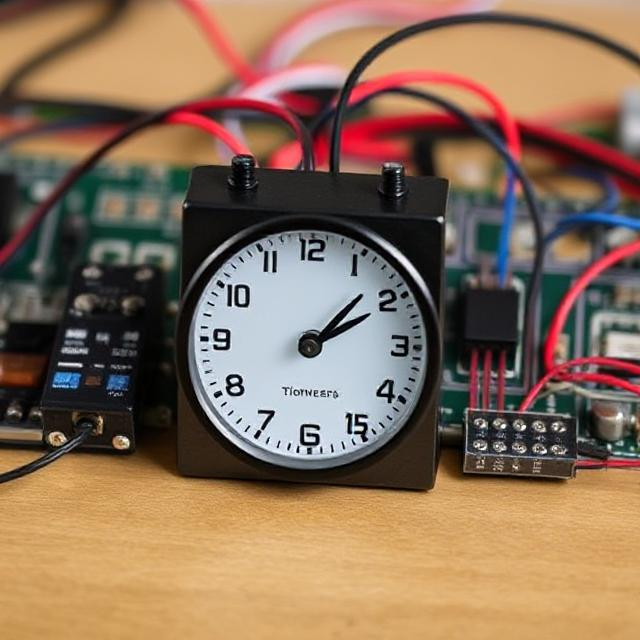In digital electronics, timers and oscillators are two important components used to manage and measure time and frequency. These devices help in controlling the operation of circuits, generating clock signals, and ensuring everything works in sync.

Whether it’s your alarm clock, microwave oven, or a computer, these devices use timers and oscillators to function correctly. Let’s explore what they are, how they work, and why they are essential in electronics.
What is a Timer?
A timer is a device that counts time. It can be used to delay an action, measure the time between events, or generate precise timing signals.
Types of Timers:
-
Monostable Timer: Produces a single pulse when triggered. It is used for generating time delays.
-
Astable Timer: Continuously produces a series of pulses. It’s used as a clock or pulse generator.
-
Bistable Timer: Changes output state when triggered and stays in that state until triggered again.
Common Timer IC: 555 Timer
The 555 timer is one of the most popular timer integrated circuits (ICs). It can be used in all three modes: monostable, astable, and bistable. It is easy to use and inexpensive.
Applications of Timers:
-
Blinking LEDs
-
Generating sound in buzzers
-
Creating time delays
-
Measuring time intervals
-
Controlling motors or lights for a specific time
What is an Oscillator?
An oscillator is a circuit that produces a continuous, repeating signal, usually in the form of a sine wave or square wave. It does not need any external input signal to keep working.
Oscillators are used to create clock signals for digital circuits. These clock signals act like a heartbeat for a computer or microcontroller, helping them keep track of time and control processes.
Types of Oscillators:
-
Crystal Oscillator: Uses a quartz crystal to produce very accurate frequency.
-
RC Oscillator: Uses resistors and capacitors. It’s simple but not very precise.
-
LC Oscillator: Uses inductors and capacitors. Mostly used in radio frequency (RF) applications.
Applications of Oscillators:
-
Clocks and watches
-
Microcontrollers and processors
-
Radios and televisions
-
Communication systems
Timers vs Oscillators
| Feature | Timer | Oscillator |
|---|---|---|
| Purpose | Measures time or delays | Generates continuous signals |
| Output | Can be one-time or repeating | Always repeating (waveform) |
| Examples | 555 Timer | Crystal Oscillator |
| Common Use | Time delays, counting | Clock signals, frequency control |
Why Are They Important?
Timers and oscillators are essential because they help digital systems keep time and operate in a synchronized way. Without them, it would be hard for devices to perform tasks at the right time or communicate correctly.
For example, in a computer, an oscillator sets the speed of the processor. In a traffic light system, timers help change the lights at the correct intervals.
Conclusion
Timers and oscillators are the timekeepers of the digital world. From simple gadgets to complex systems, they play a crucial role in making electronic devices work smoothly and accurately. Understanding these components is an important step for anyone learning about digital electronics.
By using components like the 555 timer or a crystal oscillator, engineers can design circuits that are reliable, efficient, and precise. Whether you are a beginner or a student of electronics, learning how timers and oscillators work opens the door to many exciting projects and innovations.
Tags: 555 timer, astable timer, beginner electronics, bistable timer, blinking LEDs, buzzer sound generation, circuit control, clock signals, clocks and watches, Communication Systems, continuous signal, crystal oscillator, digital electronics, digital system operation, efficient design, electronic timing, electronics fundamentals., engineering components, frequency control, frequency generators, frequency stability, heartbeat signal, inductor-capacitor oscillator, LC Oscillator, microcontrollers, monostable timer, motor control, one-time signal, oscillator circuit, oscillators, precise timing, processor clock, Processors, pulse generation, pulse width, quartz crystal, Radios, RC Oscillator, Reliable circuits, repeating waveform, resistor-capacitor oscillator, RF applications, signal generation, sine wave, square wave, student projects, synchronization, synchronized tasks, synchronizing circuits, televisions, time delay, time delays, time intervals, time measurement, timer IC, Timers, timers vs oscillators, timing control, timing devices, traffic light system, waveform generation

